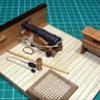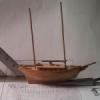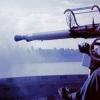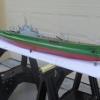Supplies of the Ship Modeler's Handbook are running out. Get your copy NOW before they are gone! Click on photo to order.
×
-
Posts
5,869 -
Joined
-
Last visited
Reputation Activity
-
 BANYAN got a reaction from thibaultron in Tackles With Lots of Rope In Between
BANYAN got a reaction from thibaultron in Tackles With Lots of Rope In Between
Hi Eberhard, thanks for your comments, and yep they come in various guises and brands. I have three different sizes with the larger ones used for shrouds and the like. Not sure of the brand name of mine but they were relatively cheap to acquire from the local electronics store - I think the smaller ones are used for testing circuit boards and the like. Sure are a lot cheaper on eBay :).
cheers
Pat
-
 BANYAN got a reaction from thibaultron in Tackles With Lots of Rope In Between
BANYAN got a reaction from thibaultron in Tackles With Lots of Rope In Between
Hi Mike, as per Jud and I tend to rig mine off the model first using the vertical (adjustable) part of my rigging station shown below. i adjust this to the right distance apart (just longer than needed), clip the hooks into the alligator clamps (with both block facing the same way - end on or side on) and rig it here before transferring to the ship. If two single blocks, start with the rigging line attached to the heel of the upper block, run to bottom block threading from front to back, up to the top block threading back to front then down to the bottom block. Cut the running end allowing enough to form several loops or coils after belaying. Use a micro clip (see other photo - available from electronics stores) to temp hold the running end to the other parts of the tackle lines. The trick is to ensure you do not twist this setup during transfer
This station (rigging crab) is based on one designed by the late Hubert Sicard (Wooden Ship Modelling for Dummies).
I hope that helps?
-
 BANYAN got a reaction from mtaylor in Bismarck by Dan Vadas - FINISHED - GPM - 1:200 - CARD and PE
BANYAN got a reaction from mtaylor in Bismarck by Dan Vadas - FINISHED - GPM - 1:200 - CARD and PE
Glad to hear you were able to resolve it Danny; the model is looking very good.
cheers
Pat
-
 BANYAN got a reaction from mtaylor in Bismarck by Dan Vadas - FINISHED - GPM - 1:200 - CARD and PE
BANYAN got a reaction from mtaylor in Bismarck by Dan Vadas - FINISHED - GPM - 1:200 - CARD and PE
Hi Danny, you will get many conflicting results from google or similar searches as the direction was a design criteria and differed from ship Class to ship Class. Even to this day, ships have different propellor configurations to meet the design requirements, which are determined by the winning bidder/tender (and accepted by the Navy/Company) unless specifically detailed in the tender request/Contract. There are arguments offered about fuel economy versus maneuverability etc etc. for the different configurations. Also, as you have summised you need sufficient flow over the rudders to make them effective. Even with twin rudders, if they were not big enough, or incorrectly placed, they may not have been effective with a particular screw configuration.
Unless you can find a contract or authoritative document that states what the configuration was, I would recommend the best way to determine this would be to look at any photos of the screws if any exist. The pitch of the blades (I think they were all fixed pitch in these days) will indicate which way they turned? For the central screw, I would not be surprised if it turned in the same direction as the motor output to minimise gearing and complication. It may also be that this screw was only used if extra/the highest speed was needed. That does not help you determine the direction, but apart from the pitch, if you know the motor/engine type, it may be possible to trace that back as well to find it's mechanical properties .....
I would be very surprised that a ship of this fame did not have propulsion information, including about the screws, published about it somewhere.
cheers
Pat
-
 BANYAN got a reaction from popeye the sailor in Bismarck by Dan Vadas - FINISHED - GPM - 1:200 - CARD and PE
BANYAN got a reaction from popeye the sailor in Bismarck by Dan Vadas - FINISHED - GPM - 1:200 - CARD and PE
Glad to hear you were able to resolve it Danny; the model is looking very good.
cheers
Pat
-
 BANYAN got a reaction from Canute in Bismarck by Dan Vadas - FINISHED - GPM - 1:200 - CARD and PE
BANYAN got a reaction from Canute in Bismarck by Dan Vadas - FINISHED - GPM - 1:200 - CARD and PE
Glad to hear you were able to resolve it Danny; the model is looking very good.
cheers
Pat
-
 BANYAN got a reaction from popeye the sailor in Bismarck by Dan Vadas - FINISHED - GPM - 1:200 - CARD and PE
BANYAN got a reaction from popeye the sailor in Bismarck by Dan Vadas - FINISHED - GPM - 1:200 - CARD and PE
Hi Danny, you will get many conflicting results from google or similar searches as the direction was a design criteria and differed from ship Class to ship Class. Even to this day, ships have different propellor configurations to meet the design requirements, which are determined by the winning bidder/tender (and accepted by the Navy/Company) unless specifically detailed in the tender request/Contract. There are arguments offered about fuel economy versus maneuverability etc etc. for the different configurations. Also, as you have summised you need sufficient flow over the rudders to make them effective. Even with twin rudders, if they were not big enough, or incorrectly placed, they may not have been effective with a particular screw configuration.
Unless you can find a contract or authoritative document that states what the configuration was, I would recommend the best way to determine this would be to look at any photos of the screws if any exist. The pitch of the blades (I think they were all fixed pitch in these days) will indicate which way they turned? For the central screw, I would not be surprised if it turned in the same direction as the motor output to minimise gearing and complication. It may also be that this screw was only used if extra/the highest speed was needed. That does not help you determine the direction, but apart from the pitch, if you know the motor/engine type, it may be possible to trace that back as well to find it's mechanical properties .....
I would be very surprised that a ship of this fame did not have propulsion information, including about the screws, published about it somewhere.
cheers
Pat
-
 BANYAN got a reaction from mtaylor in Tackles With Lots of Rope In Between
BANYAN got a reaction from mtaylor in Tackles With Lots of Rope In Between
Hi Eberhard, thanks for your comments, and yep they come in various guises and brands. I have three different sizes with the larger ones used for shrouds and the like. Not sure of the brand name of mine but they were relatively cheap to acquire from the local electronics store - I think the smaller ones are used for testing circuit boards and the like. Sure are a lot cheaper on eBay :).
cheers
Pat
-
 BANYAN got a reaction from cog in Bismarck by Dan Vadas - FINISHED - GPM - 1:200 - CARD and PE
BANYAN got a reaction from cog in Bismarck by Dan Vadas - FINISHED - GPM - 1:200 - CARD and PE
Glad to hear you were able to resolve it Danny; the model is looking very good.
cheers
Pat
-
 BANYAN got a reaction from Canute in Bismarck by Dan Vadas - FINISHED - GPM - 1:200 - CARD and PE
BANYAN got a reaction from Canute in Bismarck by Dan Vadas - FINISHED - GPM - 1:200 - CARD and PE
Hi Danny, you will get many conflicting results from google or similar searches as the direction was a design criteria and differed from ship Class to ship Class. Even to this day, ships have different propellor configurations to meet the design requirements, which are determined by the winning bidder/tender (and accepted by the Navy/Company) unless specifically detailed in the tender request/Contract. There are arguments offered about fuel economy versus maneuverability etc etc. for the different configurations. Also, as you have summised you need sufficient flow over the rudders to make them effective. Even with twin rudders, if they were not big enough, or incorrectly placed, they may not have been effective with a particular screw configuration.
Unless you can find a contract or authoritative document that states what the configuration was, I would recommend the best way to determine this would be to look at any photos of the screws if any exist. The pitch of the blades (I think they were all fixed pitch in these days) will indicate which way they turned? For the central screw, I would not be surprised if it turned in the same direction as the motor output to minimise gearing and complication. It may also be that this screw was only used if extra/the highest speed was needed. That does not help you determine the direction, but apart from the pitch, if you know the motor/engine type, it may be possible to trace that back as well to find it's mechanical properties .....
I would be very surprised that a ship of this fame did not have propulsion information, including about the screws, published about it somewhere.
cheers
Pat
-
 BANYAN got a reaction from mtaylor in Chebece 1750 by Jeronimo - FINISHED
BANYAN got a reaction from mtaylor in Chebece 1750 by Jeronimo - FINISHED
Great finish Karl - you never disappoint with the quality of your work.
cheers
Pat
-
 BANYAN reacted to Rustyj in Cutter Cheerful 1806 by Rustyj - FINISHED - 1:48 Scale
BANYAN reacted to Rustyj in Cutter Cheerful 1806 by Rustyj - FINISHED - 1:48 Scale
Unlike away druxey cuz I sure don't like it.
Hey Dubz deconstruction is way to common here!
-
 BANYAN reacted to michael mott in Young America 1853 by EdT - FINISHED - extreme clipper
BANYAN reacted to michael mott in Young America 1853 by EdT - FINISHED - extreme clipper
Ed the more that I look at the work you are doing the more I sit in awe.
In the last picture there is what appears to be an open double hook that looks a bit delicate, is this just a temporary one or does it actually look that way?
Michael
-
 BANYAN reacted to EdT in Young America 1853 by EdT - FINISHED - extreme clipper
BANYAN reacted to EdT in Young America 1853 by EdT - FINISHED - extreme clipper
Thanks, everyone for the comments and likes.
I know about that hook, Micheal. Sometimes photos show what you otherwise don't see. Its on my list to be corrected. These hooks are 26 gauge wire, but stand up pretty well to the tension on the lines - although they can be over-stressed and perhaps this one was. Thanks for your eagle-eye. Not a lot gets overlooked in these close-up photos - but that can be helpful.
Ed
-
 BANYAN reacted to shipmodel in SS Michelangelo 1962 by shipmodel - FINISHED - 1/350 scale
BANYAN reacted to shipmodel in SS Michelangelo 1962 by shipmodel - FINISHED - 1/350 scale
Hi again –
Just a quick note. In the last segment I was uncertain about how the stern access doors were represented. Even though they are just 2mm x 4mm, the dark lines were visibly jarring. Others noted this as well, and one sent me a private message with his opinion that the doors did not match the quality of the rest of the work. He was, of course, correct.
Taking that to heart, I removed the inked lines and, after several experiments, replaced them with lines drawn with a sharp, soft pencil guided by a flexible straightedge. Below, the before and after photos. I think you will agree that the look of the doors has been substantially improved even if, under magnification, they are still not perfect.
On a side note, I want to thank the modeler who was brave enough to put forward a criticism of my work in a timely manner. Although I do appreciate and cherish the compliments and likes, we are none of us perfect. Certainly not me. So if you do see something that you think can be improved, please, Please, do not keep it to yourself. If I have stopped at ‘good enough’ I need my feet held to the fire until I go back and make it ‘good.’
PS - since I saw it under magnification, I removed the little green tab that sticks up from the green sheer stripe just to starboard of the doors. Not a big change, but I felt better after doing it.
Thanks again.
Dan
-
 BANYAN reacted to dvm27 in MONTAÑES by Amalio
BANYAN reacted to dvm27 in MONTAÑES by Amalio
Look a bit closer and it's even more impressive Pat. The starboard gudgeons (on the planked side) are much thinner than on the unplanked port side. An elegant solution to a half planked hull!
-
 BANYAN reacted to cog in IJN Musashi by cog - Tamiya - 1:350 - PLASTIC - old tool
BANYAN reacted to cog in IJN Musashi by cog - Tamiya - 1:350 - PLASTIC - old tool
Thanks Pat, I hope it does ... there is but one way to find out ...
Still busy with the grandchild's (deck) furniture ? Enjoy it while you can
-
 BANYAN reacted to Old Collingwood in HMS Warspite by Old Collingwood - FINISHED - Academy - 1/350 scale - PLASTIC
BANYAN reacted to Old Collingwood in HMS Warspite by Old Collingwood - FINISHED - Academy - 1/350 scale - PLASTIC
Hi folks I have probably shown this before - but this is the stage I am building her from - 1944 D Day off the French coast.
OC.
-
 BANYAN got a reaction from mtaylor in SS Michelangelo 1962 by shipmodel - FINISHED - 1/350 scale
BANYAN got a reaction from mtaylor in SS Michelangelo 1962 by shipmodel - FINISHED - 1/350 scale
Nice work on the hull Dan, looks very good.
cheers
Pat
-
 BANYAN got a reaction from jud in Tackles With Lots of Rope In Between
BANYAN got a reaction from jud in Tackles With Lots of Rope In Between
Hi Eberhard, thanks for your comments, and yep they come in various guises and brands. I have three different sizes with the larger ones used for shrouds and the like. Not sure of the brand name of mine but they were relatively cheap to acquire from the local electronics store - I think the smaller ones are used for testing circuit boards and the like. Sure are a lot cheaper on eBay :).
cheers
Pat
-
 BANYAN got a reaction from Piet in IJN Musashi by cog - Tamiya - 1:350 - PLASTIC - old tool
BANYAN got a reaction from Piet in IJN Musashi by cog - Tamiya - 1:350 - PLASTIC - old tool
Should look good with final coat Carl, nice work.
cheers
Pat
-
 BANYAN reacted to EdT in Young America 1853 by EdT - FINISHED - extreme clipper
BANYAN reacted to EdT in Young America 1853 by EdT - FINISHED - extreme clipper
Young America - extreme clipper 1853
Part 245 – Main Topmast Stay
First some backtracking. The first picture shows a sheer stave being lashed to the fore topmast shrouds.
I initially omitted these but reconsidered after being prompted by a comment (Thanks, Scott) and checking through some sources. This is a 1½" diameter wood stave as opposed to the served 1" iron poles on the lower shrouds. The excess ends and the loose lashing ends will be removed later. This picture shows the starboard topmast backstays. The next picture shows the 10½" backstays on both sides placed over the masthead.
Before securing these at the channels below, I decided to install the 9" main topmast stay - for two reasons. First, it will be easier to use the backstays with their lanyards for final tensioning rather than the forward stay that loops through shackled bullseyes on the deck. Second, I have been anticipating a difficult task in fixing this stay at the lower end and wanted to get on with it. In the next picture, the stay is looped over the masthead and being marked at the limits of the upper serving where the two legs will be seized.
The lower ends of both legs of this stay are also served from abaft of the foremast, down through the bullseyes, and back up to the ends of the seized legs – as will be seen below. The next picture shows one of the long lower legs being served.
The needle through the rope marls the end of the served length and will allow the thread to be pulled through the rope at that point to fix the end. The next picture shows the lower ends being fastened to the shackled bullseyes.
Making these ends fast in the tight space was even more difficult than I expected, mainly because I did not allow sufficient diameter in the bullseye holes to easily pass the served line. I spent almost an hour getting the port leg through the bullseye, including refitting the bullseye into the shackle several times. The picture shows that side seized and the stay being pulled through the starboard bullseye. After enlarging this bullseye hole at the start, this side took about a minute. There is a moral to this story.
The next picture shows the completed lower end. There are four seizings on each lower leg and simulated leathering in the area of the rubbing battens on the mast.
Another concern I had about this arrangement was clearance between the four large, doubled lines and their fixings in the deck, as well as clearance around the mast. This all worked out as planned - fortunately. The next picture shows the upper end of the stay.
The next picture shows the full completed stay.
With this stay in place, belaying on the fore fife rails may proceed without having to thread these large lines through later, meaning that work can now begin on the yards of the foremast and their many running rigging lines.
But first, completion of the main topmast backstays that are temporarily clamped in the picture.
Ed
-
 BANYAN reacted to shipmodel in SS Michelangelo 1962 by shipmodel - FINISHED - 1/350 scale
BANYAN reacted to shipmodel in SS Michelangelo 1962 by shipmodel - FINISHED - 1/350 scale
Hello again to all –
A rewarding installment this time. No major problems at all as I finished the lower hull.
While I was waiting for various deliveries during the boot topping odessey I worked on the hull details. The first were the two stowed anchors. These started life as Bluejacket castings, but were cut and ground to proper shape as shown in photos of the ship. They are not inset into the hull, as on most liners, but mounted on a triangular cleat and held with the stock in the hawse pipe.
The ship’s name is a decal made on my ink-jet printer using a white decal sheet made by Testors. Clear sheets also came in the packet, but my printer works less well on it than on the white. You may have noticed during the last installment that the name appeared and disappeared out of sequence. That was because several were made, tested and rejected for one reason or another. It is not difficult to remove a bad decal with a little more water if it has not been overcoated with finish. This is the final one.
At the stern the ship name is not done in black, but in gold. You can also see the outlines of the two sets of stern access doors that were mentioned earlier in the build with rust streaks coming down from the corners.
The doors were simply inked on with an ultra-fine tipped marker. In the photo they look a bit too bold, so I may yet adjust them. The name and home port of Genova are decals. To get them to curve around the stern I scored between each letter through the decal film but not through the paper backing. I left a small band at the bottom to hold the letters at the right distance from each other. With careful manipulation with a small paint brush and a toothpick each letter was adjusted around the curve.
Decals were made up for the plimsol mark. The mark is correct for ships flying the Italian flag, but at less than 10mm overall the letters “R” and “I” which denote the country are so small as to be almost beyond the abilities of my eyes, much less my printer. Several copies were made then varied slightly in tone before being printed out so I could select the closest match. Once the decal was applied and had dried the edges were overpainted with a bit of red and green decanted from the rattle cans.
Decals for the depth marks had to be tiny Roman Numerals. They are beyond my printer, so they were ordered and installed. These were the last decals for the hull, so everyone was snugged down with setting solution and overcoated with clear varnish to secure them permanently.
A pair of 20mm diameter counter-rotating brass propellers were sourced from Europe. A quick polishing with jeweler’s rouge on a felt cone and they were secured into the prop shaft tunnels that were tipped with brass collars.
The rudder shape was taken from the plans and cut from 2mm hardwood. An airfoil profile was sanded into it from fore to aft. It was notched to fit the rudder hinge on the hull and a hole for a brass pin was drilled up through the rudder and hinge and into the hull. After a few coats of primer and final sanding it was painted to match the lower hull and installed.
The final items on the hull are the fin stabilizers. These are small wings that take the place of the bilge keels to keep the ship from rolling. They were first reported on a Japanese cruise liner in 1933. As fixed wings they were not very successful, and were supplanted by gyroscopic stabilizers. These were too large and heavy, so they in turn were supplanted by automatically adjusted fins.
It is known from newspaper reports and articles in engineering magazines that the Michelangelo had adjustable fin stabilizers, but none of my photos of the lower hull have any visible fins. I was never able to find more details, not even how large they were. Some fins are very small, and some very large, and some in the middle.
Most stick out horizontally from the hull, but some angle down perpendicular to the curved hull. All modern ones are retractable to allow closer docking without the danger of damaging the fins. Some slid straight into the hull, while others, like the one in the photo, folded into slots in the hull.
I found some drawings of the internal machinery of the retractable fins, and two are here just because I thought my audience would appreciate them.
I made my fins from 2mm hardwood sanded to an airfoil shape and tapered from the hull outward. They are 5mm wide and 12mm long, which fits with the general appearance of fins in photos, and with my eyeball of what looks right for the size of the model. They are mounted horizontally in brass sleeves inserted in the hull.
The lower hull is now complete and the model was firmly attached to its building base. This will be replaced with a presentation base once the model is finished. In the meanwhile, the fins were removed to safe storage and the lower hull protected in bubble wrap while work on the upper decks continues.
So it’s off to the NRG conference in Florida. Hope to see many of you there.
Be well
Dan
-
 BANYAN reacted to popeye the sailor in IJN Ise 1944 by RGL - FINISHED - Fujimi - 1/350 - PLASTIC
BANYAN reacted to popeye the sailor in IJN Ise 1944 by RGL - FINISHED - Fujimi - 1/350 - PLASTIC
early catapults were steam.......the more modern ones are electromagnetic. images I saw of dual pontoon aircraft on a catapult, shows them on a cradle of sorts, and thrusted forward by steam operated pistons. I surmise it is like throwing a paper airplane having never detailed a catapult myself....I don't blame you for not moving ahead with fitting planes on them....sad that the kit or photo etch doesn't supply anything either. from what I read, the aft catapults didn't last long anyway.....they were removed to improve the effectiveness of the aft turrets. I also saw an artist's drawing of the 1944 refit....the opening that I asked about wasn't there. perhaps it was an elevator of sorts, below deck before the refit......ammo for the turrets was likely moved to them from below deck, so they would be pre detonated by stray fire or bombs. sounds logical to me anyway
-
 BANYAN reacted to RGL in IJN Ise 1944 by RGL - FINISHED - Fujimi - 1/350 - PLASTIC
BANYAN reacted to RGL in IJN Ise 1944 by RGL - FINISHED - Fujimi - 1/350 - PLASTIC
The whole thing was a failure really, the cats were removed and it didn’t achieve much. I will put planes on the cats, just not the ones without the floatplanes.









